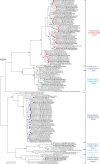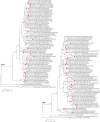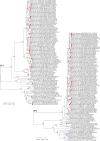Emergence of human G2P[4] rotaviruses containing animal derived gene segments in the post-vaccine era
- PMID: 27841357
- PMCID: PMC5107926
- DOI: 10.1038/srep36841
Emergence of human G2P[4] rotaviruses containing animal derived gene segments in the post-vaccine era
Erratum in
-
Erratum: Emergence of human G2P[4] rotaviruses containing animal derived gene segments in the post-vaccine era.Sci Rep. 2017 Jan 3;7:39436. doi: 10.1038/srep39436. Sci Rep. 2017. PMID: 28045042 Free PMC article. No abstract available.
Abstract
The introduction of Rotarix into the Belgian immunization program in June 2006 coincided with an increase of the relative prevalence of G2P[4] strains. However, the genetic composition of these persistent G2P[4] strains has not been investigated. Therefore, we have investigated the NSP4 gene of 89 Belgian G2P[4] strains detected between 1999 and 2013, covering both pre- and post-vaccination periods. The NSP4 genes were divided over seven separate clusters of which six were more closely related to animal than to human strains. The NSP4 genes that clustered more closely to animal DS-1-like strains were isolated after 2004-2005 and were found throughout multiple seasons. Complete genome sequencing of 28 strains identified several other gene segments that clustered more closely to animal than to human DS-1-like strains. These findings suggest that frequent interspecies reassortments may have played a role in the spread of G2P[4] rotaviruses in the post-vaccination period in Belgium.
Conflict of interest statement
J.M. serves as a consultant for GlaxoSmithKline on the genetic stability and safety aspects of the rotavirus G1P[8] vaccine strain (Rotarix). The authors declare no other competing financial interests.
Figures








References
-
- Tate J. E. et al. 2008 estimate of worldwide rotavirus-associated mortality in children younger than 5 years before the introduction of universal rotavirus vaccination programmes: a systematic review and meta-analysis. The Lancet. Infectious diseases 12, 136–141, doi: 10.1016/S1473-3099(11)70253-5 (2012). - DOI - PubMed
-
- Estes M. K. & Greenberg H. B. In Fields Virology Vol. 2 1347–1401 (2013).
Publication types
MeSH terms
Substances
LinkOut - more resources
Full Text Sources
Other Literature Sources

